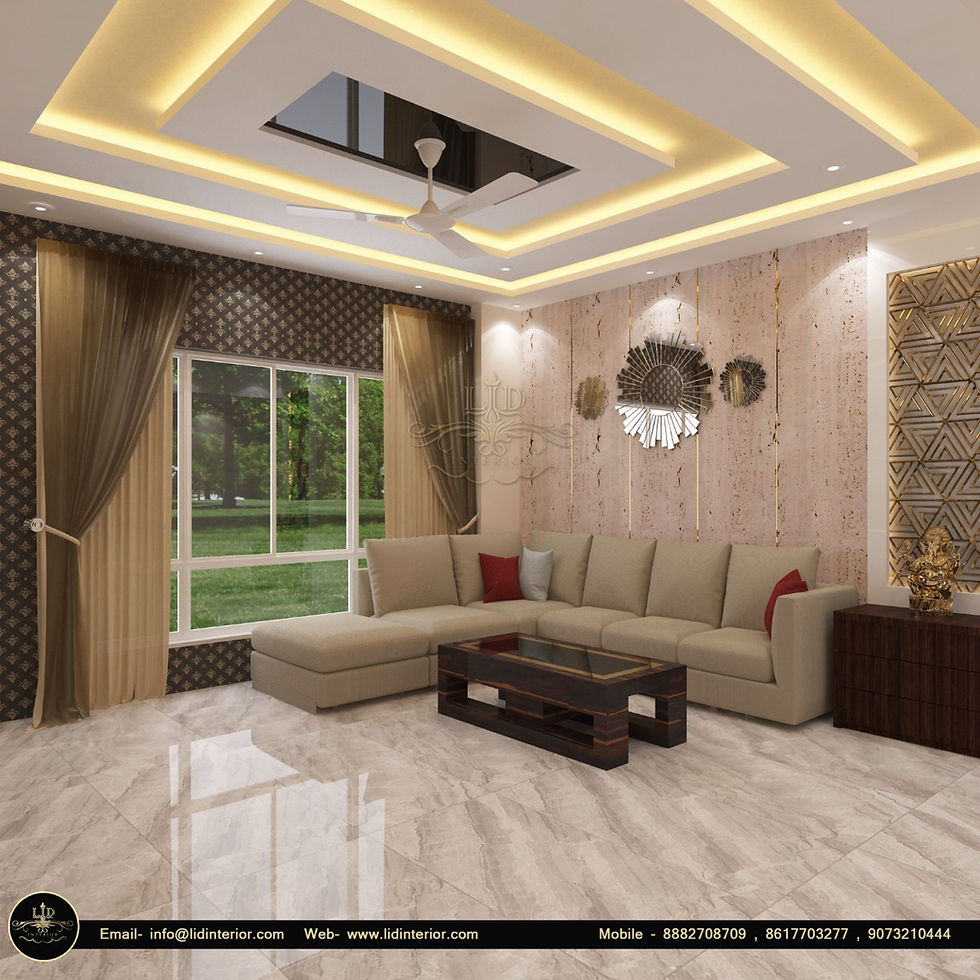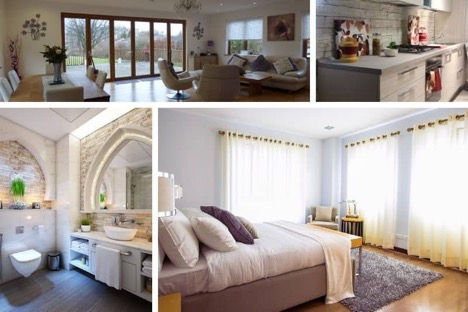5 Things to Consider When Designing Your Perfect Living Room
- LID TEAM

- Mar 28, 2020
- 5 min read
Updated: May 1, 2020
The living room becomes a refuge for cozy relaxation as soon as the evening sets in. We take recourse in our comfy sectionals to binge-watch a recent TV series or curl up in the divan near the fireplace with our favorite book.
But, the living room is not just a place where we watch TV, read books, play games and eat. It also plays a significant part in introducing who we are as a person and our choices/preferences to our guests.
And, take our word for it, designing a living room can be pretty challenging, especially if you are a first-timer.
You need to consider hundreds of minute details like, ‘how do you make a small room feel spacious while also squeezing in an extra set of chairs for the guests? What are the pieces of furniture you should include and how should you arrange it to save optimal space?’ etc.
In case you are wondering how to design living rooms and having a hard time figuring out all the intricacies, we have good news for you. We consulted with some of the most renowned interior designers of the world to prepare a detailed guide with excellent designing tips and furniture layout ideas.
Go through these top 5 ideas on living room designs, at the earliest to make the most of your living space.
Useful tips on how to design living rooms:
As a rule of thumb, you will need to maintain the basics of living room designs, i.e., ensuring there is a few inches gap between the sofa, tv set, chairs, and the coffee table and there is a clear path from one end of the room to the other so that people can pass through the room easily without tripping over the furniture every once in a while, etc.
Can’t seem to figure out how to do it right?
Then let's get on with the nitty-gritty right away.
1. Prepare a detailed layout
To begin with, you must consider the available floor space of your living room and prepare a rough sketch of the furniture you would like to include. If you skim through a few websites and online videos, you will find that most of the standard living rooms include four basic items- an armchair, coffee table, a sofa, and a TV stand. But in the end, it boils down to your preferences and choices and what your living space can afford.

Every living room has its own unique dimensions and to style the interior aptly, you will need to take cues from its layout and measurements. Begin by contemplating how you would like to organize the furniture before buying them and prepare the layout on a graph paper. You definitely wouldn't want a dining table that's too large to get through the entrance or a huge sofa that lies awkwardly near the wall.
Starting from positioning the essential furniture to adding little details like posters, rugs and wall lights, the graph-paper layout must include it all so that nothing feels out-of-scale, cramped or poorly arranged.
2. Opt for the right furniture
The interior designing experts who ideate remarkable living room designs, recommend looking for streamlined furniture to make a living room feel light and airy.
For example, you can opt for small two-seater sofas and arrange them in two different corners of the room instead of settling for a huge sectional that takes up an ample amount of space.
You can also consider buying a vertical storage wardrobe that makes use of the height rather than floor space, and set up wall lights instead of table lamps to save space.
You might want to make extra seating arrangements, add floor lamps, carpets, side tables, shoe racks and wardrobes as well. But for that, you will need to measure up the floor area to ensure everything fits in place.
In order to do it right, you can follow this idea by David Barrett, “A good place to start is to make paper templates of the pieces of furniture you want to include and arrange them in situ,”. This will be the key to ensuring the proportions of the furniture coordinates with the proportions of the living room.
Also, keep in mind that if you include recliners or sofa-cum-beds, you will need to leave enough space in between the furniture so that it gets the room it deserves when fully extended.
3. Know the focal points of the room
The focal points are those particular places that instantly grab the attention of the people as soon as they walk into your living room. Every professional interior designer, who provides ideas on living room designs, first determines the focal point of the room before they start bringing in furniture.
Generally, fireplaces or mantles serve as natural focal points. However, if your living space lacks these natural focal points, you can create one with a large artwork, a piano or an antique mirror and arrange the furniture around it.
You must also note that the first priority of designing your living room should be personalization. You can choose to hang your wedding photos, display your original artwork, or keep a piano or a guitar handy as they will not only amplify the room decor but also help you feel at home.
Of course, you would want to cater to your guests and impress them, but in the end, it's your own house and you should stay true to your preferences.
4. Vary the lighting of the room
Another essential aspect of living room designs is its lighting, which is also considered to be the "macro-structure" of every environment. So, you must learn to experiment with different shades of light, and other materials that reflect light, like mirrors, to make the room feel bright and colorful.
The position of the in-built lamps and the placement/size of the windows will play a significant part in altering the look and feel of your room. So integrate suitable amounts of lighting in the room. To do so, you can make use of both natural lighting and well as extra task lights. Keep different types of lights scattered all around the room and also consider changing your standard switches to dimmers for added versatility.
Also, you should refrain from incorporating gloomy and opaque curtains as well as keep in mind that overwhelmingly bright lights will hurt the eyes when evening falls. Lighting has the power to make or break the appeal of your room, so be sure it suits the design objectives and the aesthetics of the place.
5. Keep the other rooms in mind
It's quite natural to become consumed with the whole process of designing the living space, but keep in mind that you are not decorating it simply in a bubble. Each of the spaces of your room must have consistency and similarity with one another, and so, you must build harmony between the aesthetic of all the spaces.
For example, an understated beige room leading into a bright purple one won’t bring cohesion and seem out of place. However, it is also not mandatory that each and everything stays in perfect coordination. As the exact same color scheme in all the rooms would only make your living space look dull and boring.
Strive to bring in a rhythm and flow in all the rooms so that there is a balance between light and dark shades of cushion/ sofa cover and bright and dull pieces of furniture. Then take a stroll around the house to ensure all the spaces feel like they belong together and the living room doesn't stick out like a sore thumb.
Well, this brings us to the very end of our guide. We hope this article could provide you with a pretty balanced idea of how to design a living room and put together a beautiful space just like you had envisioned.
Good Luck!
- LID TEAM















Watch family-friendly movies and kids’ animations for free at Redecanais, perfect for quality family time. RedeCanais hd
Loan settlement
Debt settlement
Loan closure
Loan consolidation
Debt consolidation
Debt relief
Loan restructuring
Loan resolution
Loan negotiation
Debt resolution
Personal loan settlement
Home loan settlement
Business loan settlement
Education loan settlement
Credit card settlement
EMI settlement
Loan default solution
Loan repayment help
One-time loan settlement
Loan foreclosure
Loan harassment solution
Recovery agent harassment
Bank harassment calls
Loan legal help
Loan advocate services
Loan recovery solution
Anti-harassment service
Recovery agent protection
Loan legal advice
Loan dispute resolution
Debt free solutions
Manage multiple EMIs
Reduce loan EMI
Loan burden relief
Financial stress help
Loan stress settlement
Loan payoff solutions
Debt payoff help
Resolve debt issues
Clear loan fast
Expert loan settlement
Professional debt resolution
Affordable loan settlement
Best loan settlement services
the airport pune // the bn pune // the escorts pune // the hotel pune // the in pune // the pc pune //
the koregaon pune // the hinjewadi pune // the dgk pune // the balewadi pune // the baner pune //
the wakad pune // the vn pune // the sn pune // the ravet pune // the pune city // the ps pune //
the lovely desire pune //
the airport pune // the bn pune // the escorts pune // the hotel pune // the in pune // the pc pune //
the koregaon pune // the hinjewadi pune // the dgk pune // the balewadi pune // the baner pune //
the wakad pune // the vn pune // the sn pune // the ravet pune // the pune city // the ps pune //
the lovely desire pune //
Great tips on designing the perfect living room! I believe a well-designed space isn’t just about aesthetics—it’s also about creating an atmosphere where you can truly relax and enjoy your time. For me, that includes some online entertainment after a long day. Platforms like Reddy Book Club offer real money casino games that are perfect for winding down in a cozy, comfortable setting. If you enjoy mixing style with excitement, check it out!